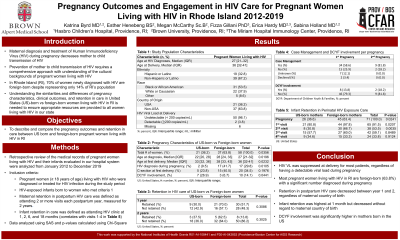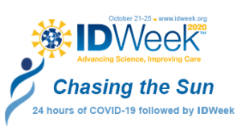Category: HIV: Epidemiology and Screening
Poster Session: HIV: Epidemiology and Screening
966 - Pregnancy Outcomes and Engagement in HIV Care for Pregnant Women Living with HIV in Rhode Island 2012-2019


Katrina M. Byrd
Infectious Disease Fellow
Brown University
Providence, Rhode IslandDisclosure: I do not have any relevant financial / non-financial relationships with any proprietary interests.
- EH
Esther Henebeng
Medical Student
Brown University
Providence, Rhode IslandDisclosure: I do not have any relevant financial / non-financial relationships with any proprietary interests.

Meghan L. McCarthy
Research Assistant/Medical Student
The Miriam Hospital
Providence, Rhode IslandDisclosure: I do not have any relevant financial / non-financial relationships with any proprietary interests.
- FG
Fizza S. Gillani
Assistant Professor
Brown Alpert Medical School, Providence RI, USA
Providence, Rhode IslandDisclosure: I do not have any relevant financial / non-financial relationships with any proprietary interests.

Erica J. Hardy
Assistant Professor
Alpert Medical School of Brown University / Women & Infants Hospital
Providence, RIDisclosure: I do not have any relevant financial / non-financial relationships with any proprietary interests.
- SH
Sabina D. Holland
Assistant Professor
Brown University
Providence, Rhode IslandDisclosure: I do not have any relevant financial / non-financial relationships with any proprietary interests.
Presenting Author(s)
Co-Author(s)
Background: Prevention of mother to child transmission (PMTCT) of Human Immunodeficiency Virus (HIV) requires a comprehensive approach and understanding the cultural backgrounds of pregnant women living with HIV (PWLH). In Rhode Island (RI), 70% of women newly diagnosed with HIV are foreign-born (FB) despite only representing 14% of RI’s population. Understanding the similarities and differences of pregnancy characteristics and engagement in postpartum HIV care between United States born (USB) and FB women is needed to ensure PWLH remain engaged in care and that appropriate resources are provided to all women with HIV in our state to maintain successful PMTCT of HIV.
Methods: A retrospective review of pregnant women living with HIV and their HIV-exposed infants evaluated in our hospital system were analyzed from 2012-2019. Clinical data were derived from medical records. Association between country of origin and sociodemographic, clinical, or lab variables were evaluated using chi-square test.
Results:
A total of 72 pregnancies in 64 PWLH were included. Median # of pregnancies were 9 per year, median age at delivery 33 years, 54% of PWLH Black or African American, 33% Hispanic; 67.1% FB, most (56%) from Sub-Saharan Africa. Sixty-one % (n=42) with detectable ( > 20 copies/mL) viral load (VL) during pregnancy, 23% (n=15) at delivery, only 1 VL > 200 at delivery. Pregnancy complications seen in 51%; 60% delivered vaginally; most (74%) at term. Engagement in postpartum HIV care declined from 71% at 6 months to 37% at 24 months. There was also decline in engagement in HIV care for the HIV exposed infants- 89% presented to the initial visit their children, from 89% attending the initial visit to 69% attending their last. DCYF involvement was more likely to occur in USB women compared to FB (P < 0.05). Other comparisons between FB & USB women including adherence to care were insignificant.
Conclusion: USB PWLH are at higher risk of DCYF involvement compared to FB women. Investigation into this disparity is warranted, given the cultural and language differences between groups. Additional research to determine barriers to long-term postpartum follow up for women and their infants is urgently needed.

